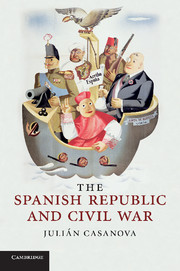Book contents
- Frontmatter
- Contents
- List of maps
- Chronology
- Introduction
- Part I Republic
- Part II Civil war
- 6 From coup d'état to civil war
- 7 Order, revolution and political violence
- 8 An international war
- 9 The Republic at war
- 10 ‘Nationalist’ Spain
- 11 Battlefields and rearguard politics
- Epilogue: Why did the Republic lose the war?
- Glossary
- Appendix 1 Leading figures
- Appendix 2 Political parties and organisations
- Index
- References
11 - Battlefields and rearguard politics
Published online by Cambridge University Press: 05 June 2012
- Frontmatter
- Contents
- List of maps
- Chronology
- Introduction
- Part I Republic
- Part II Civil war
- 6 From coup d'état to civil war
- 7 Order, revolution and political violence
- 8 An international war
- 9 The Republic at war
- 10 ‘Nationalist’ Spain
- 11 Battlefields and rearguard politics
- Epilogue: Why did the Republic lose the war?
- Glossary
- Appendix 1 Leading figures
- Appendix 2 Political parties and organisations
- Index
- References
Summary
In the three months following the July 1936 uprising, the war was a struggle between armed militias, who lacked the basic elements of a conventional army, and a military power that concentrated all its resources in authority, discipline and the declaration of martial law, and that almost from the start was able to employ the services of the well-trained troops of the Africa army.
The Battle of Madrid, in November of that year, saw the arrival of a new form of waging war and transformed this group of militiamen into soldiers in a new army. After the failure of various attempts to take Madrid, between November 1936 and March 1937, Franco changed his strategy and chose to unleash a war of attrition, the gradual occupation of territory and total destruction of the republican army. His materiel and offensive superiority led him to the final victory two years later.
‘Wars are lost in the rearguard’, wrote General Vicente Rojo. And this is what was happening to the Republic, where hunger created major conflicts as the war went on, and one defeat after another ended up demoralising large sectors of the population, who abandoned their commitment to the values and material interests they were fighting for. The air-raids by the Italians and Germans on Madrid, Valencia and Barcelona also helped Franco to win the war.
- Type
- Chapter
- Information
- The Spanish Republic and Civil War , pp. 304 - 334Publisher: Cambridge University PressPrint publication year: 2010

